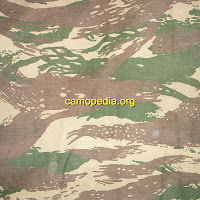The Hellenic Armed Forces (Eλληνικές Ένοπλες Δυνάμεις) have largely been influenced by the camouflage developments of other nations, namely France, Portugal and the United States. Yet most of the camouflage clothing adopted by the Greek military is stamped with a particularly indigenous style of its own. Both the French tenue leopard pattern developed in the 1950s, and the Portuguese M1963 "vertical lizard" patterns have influenced Greek designs, and in recent years elite units of the Greek Army and Navy have also adopted copies of pixelated camouflage patterns developed by the United States.
The first camouflage pattern produced locally was a copy of the original French tenue leopard or "lizard" design, introduced in the mid-1970s. The design seems to use the original late French lizard pattern drawings and colors, and was printed on a heavy HBT cotton fabric.
Subsequent to the direct copy of French lizard were several variations of the basic drawings incorporating a slightly more disruptive element to the stripes in the pattern. Two main versions are known, having either a primarily tan or pale green background color, yet in fact there seems to be additional variability depending on what type of fabric the pattern is printed on. Overlapping brushstrokes of dark brown & dark olive green complete the design. This camouflage pattern is generally the most commonly associated with the Hellenic Armed Forces, being worn at various times by Army, Navy and Air Force personnel. It is commonly referred to as "Greek lizard" pattern. The four patterns illustrate this variability and range from the most tan background on the far left, to the most green on the far right.
Source: Wikipedia , Camopedia






No comments :
Post a Comment